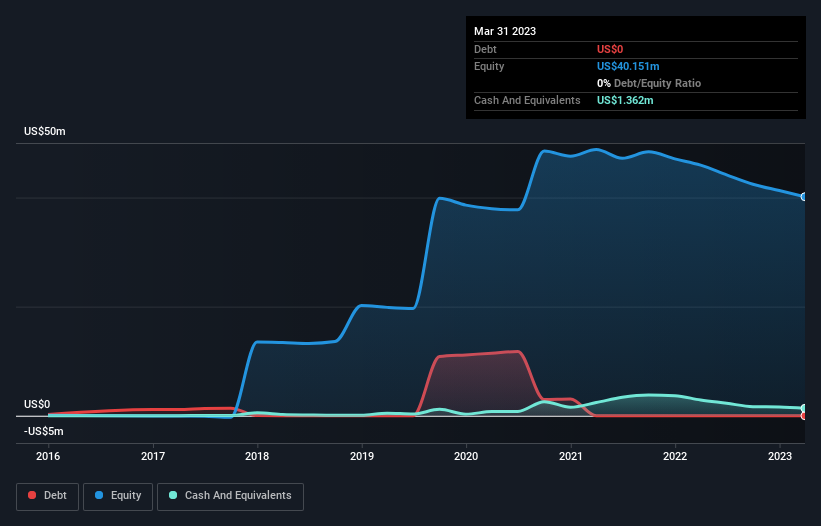Even after rising 10% this past week, Sailfish Royalty (CVE:FISH) shareholders are still down 15% over the past three years
This month, we saw the Sailfish Royalty Corp. (CVE:FISH) up an impressive 32%. But that cannot eclipse the less-than-impressive returns over the last three years. Truth be told the share price declined 24% in three years and that return, Dear Reader, falls short of what you could have got from passive investing with an index fund.
While the last three years has been tough for Sailfish Royalty shareholders, this past week has shown signs of promise. So let's look at the longer term fundamentals and see if they've been the driver of the negative returns.
Check out our latest analysis for Sailfish Royalty
Sailfish Royalty recorded just US$2,600,215 in revenue over the last twelve months, which isn't really enough for us to consider it to have a proven product. This state of affairs suggests that venture capitalists won't provide funds on attractive terms. So it seems shareholders are too busy dreaming about the progress to come than dwelling on the current (lack of) revenue. For example, investors may be hoping that Sailfish Royalty finds some valuable resources, before it runs out of money.
We think companies that have neither significant revenues nor profits are pretty high risk. We can see that they needed to raise more capital, and took that step recently despite the fact that it would have been dilutive to current holders. While some companies like this go on to deliver on their plan, making good money for shareholders, many end in painful losses and eventual de-listing.
Sailfish Royalty only just had cash in excess of all liabilities when it last reported. So it is a good thing that the company has looked to remedy the situation by raising more capital recently. The cash situation might not explain why the share price is down 8% per year, over 3 years. You can see in the image below, how Sailfish Royalty's cash levels have changed over time (click to see the values).
In reality it's hard to have much certainty when valuing a business that has neither revenue or profit. Would it bother you if insiders were selling the stock? I would feel more nervous about the company if that were so. It only takes a moment for you to check whether we have identified any insider sales recently.
What About Dividends?
As well as measuring the share price return, investors should also consider the total shareholder return (TSR). The TSR incorporates the value of any spin-offs or discounted capital raisings, along with any dividends, based on the assumption that the dividends are reinvested. So for companies that pay a generous dividend, the TSR is often a lot higher than the share price return. As it happens, Sailfish Royalty's TSR for the last 3 years was -15%, which exceeds the share price return mentioned earlier. The dividends paid by the company have thusly boosted the total shareholder return.
A Different Perspective
Sailfish Royalty shareholders are down 3.2% for the year (even including dividends), but the market itself is up 4.8%. Even the share prices of good stocks drop sometimes, but we want to see improvements in the fundamental metrics of a business, before getting too interested. Longer term investors wouldn't be so upset, since they would have made 3%, each year, over five years. It could be that the recent sell-off is an opportunity, so it may be worth checking the fundamental data for signs of a long term growth trend. It's always interesting to track share price performance over the longer term. But to understand Sailfish Royalty better, we need to consider many other factors. Like risks, for instance. Every company has them, and we've spotted 4 warning signs for Sailfish Royalty (of which 2 are a bit concerning!) you should know about.
There are plenty of other companies that have insiders buying up shares. You probably do not want to miss this free list of growing companies that insiders are buying.
Please note, the market returns quoted in this article reflect the market weighted average returns of stocks that currently trade on Canadian exchanges.
Have feedback on this article? Concerned about the content? Get in touch with us directly. Alternatively, email editorial-team (at) simplywallst.com.
This article by Simply Wall St is general in nature. We provide commentary based on historical data and analyst forecasts only using an unbiased methodology and our articles are not intended to be financial advice. It does not constitute a recommendation to buy or sell any stock, and does not take account of your objectives, or your financial situation. We aim to bring you long-term focused analysis driven by fundamental data. Note that our analysis may not factor in the latest price-sensitive company announcements or qualitative material. Simply Wall St has no position in any stocks mentioned.

 Yahoo Finance
Yahoo Finance 
